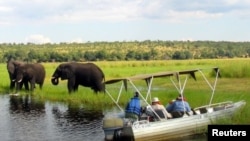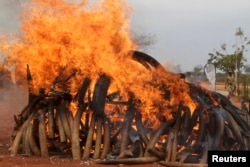A recent aerial survey of Zambia’s elephant population shows that anti-poaching efforts are having a positive impact on the country’s national parks. The Zambia Department of National Parks and Wildlife participated in the Great Elephant Survey which included 20 countries across the continent. It was the first pan-African elephant census in 40 years.
The Great Elephant Census was funded by Paul G. Allen’s Vulcan Inc. and supported by The Nature Conservancy. It was initially launched in 2013 across Africa where researchers used a standardized method of data collection to create an up-to-date picture of the status of African elephants. The Zambia elephant survey completes the census. It found that elephant numbers are stable in some areas but continued efforts are needed to tackle poaching.
Matt Brown, director of conservation for the Nature Conservancy Africa explained that the survey was conducted in a six week period during the dry season across four national park complexes in Zambia.
The aerial survey was conducted over 21 million acres of Zambia that included national parks and game management areas. The focal areas included Kafue and Sioma Ngwezi National Parks and the Luangwa Valley and Lower Zambezi systems.
Brown says the results showed the elephant population was doing better than anticipated.
“There were 21,000 elephants that were counted which is a good result for Zambia. So the carcasses we found were in a sustainable range. So in general it was a positive survey showing that there’s actually a stable elephant population in Zambia across the whole country,” highlighted Brown.
Counting the elephant carcasses and noting the approximate age of those carcasses showed that the deaths were within sustainable levels and the country’s population of elephants was stable, even increasing, corroborating the live elephant counts.
However some areas of concern were noted.
”In one of them the elephants had been hit very hard. It’s right on the Angola border and so there’s been a lot of poaching in that area,” said Brown, who added, “and then another system is actually doing better than expected and yes that’s a result of good anti-poaching work--in the Kafue National Park.
“There’s a group called Game Rangers International that works closely with the Zambian government, and they’ve been very successful at increasing the anti-poaching efforts, hiring village game scouts and doing a good job of protecting and controlling in that park. But it’s not uniform across the country," Brown asserted.
He said the increased enforcement of anti-poaching efforts has raised the importance of prioritizing the protection of elephants. However protection initiatives may need to be intensified in areas where the elephant population is facing more significant threats.
“There needs to be a continual stream of funding still. A lot of these areas are funded through tourism revenue and we need more revenue. It therefore means we need to continue with this anti-poaching effort in the near term while the price of ivory is still high and while the demand is high. In the long term a key issue for elephants is habitat. And so we need to continue to work on all of the conservation efforts and on the community conservation outside of the parks to make sure that these elephants have viable habitat for the future,” Brown explained.
Looking ahead, he said the government of Zambia has indicated that they will launch a working group to determine not only how they can continue to protect the present elephant population but how they can build on their successful initiatives to see the elephant population grow.







